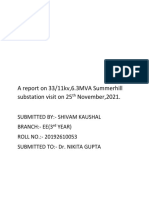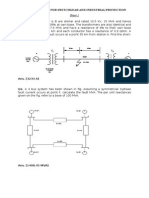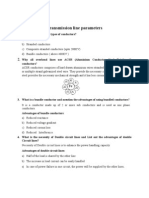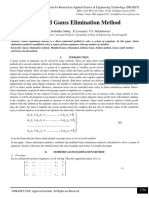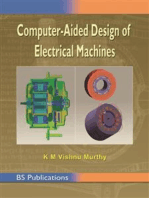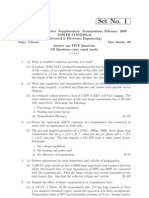Power Systems II JNTU Paper
Power Systems II JNTU Paper
Uploaded by
Shivakrishna MulkaCopyright:
Available Formats
Power Systems II JNTU Paper
Power Systems II JNTU Paper
Uploaded by
Shivakrishna MulkaCopyright
Available Formats
Share this document
Did you find this document useful?
Is this content inappropriate?
Copyright:
Available Formats
Power Systems II JNTU Paper
Power Systems II JNTU Paper
Uploaded by
Shivakrishna MulkaCopyright:
Available Formats
Code No: R05310203
Set No. 1
III B.Tech I Semester Regular Examinations, November 2007 POWER SYSTEMS-II (Electrical & Electronic Engineering) Time: 3 hours Max Marks: 80 Answer any FIVE Questions All Questions carry equal marks 1. (a) What are bundled conductors? Discuss the advantages of bundled conductors, when used for overhead lines. (b) Calculate the capacitance (phase-to-neutral) of a three-phase 100 km long double circuit line shown in Figure 1b, with conductors of diameter 2.0 cm each arranged at the corners of an hexagon with sides measuring 2.1 m. [8+8]
Figure 1b 2. (a) Dene A, B,C and D constants of a transmission line? What are their values in short lines? (b) A 3-phase, 3km long line delivers 3000kW at a power factor of 0.8 lagging to a load. If the voltage at the supply end is 11kV, determine the voltage at the load end, percentage regulation, sending end power factor and the eciency of transmission. The resistance and reactance per km of each conductor are 0.4 ohm and 0.3 ohm respectively. [6+10] 3. (a) Derive equations which represent the performance of a long transmission line with its electrical parameters uniformly distributed along its length. (b) The per-unit-length parameters of a 132kV, 350km, 50Hz, three phase long transmission line are y=j2.5106 mhos per km per phase and z = (0.2 + j 0.4) ohm/km. The line supplies a 130 MW load at 0.8 power factor lagging. Determine i. the voltage regulation, ii. the sending-end power and iii. the eciency of transmission.
[8+8]
1 of 2
Code No: R05310203
Set No. 1
4. (a) Derive reection and refraction coecient of transmission line when receiving end is open circuited. (b) An overhead line has a surge impedance of 450 . A surge voltage V= 250(e0.05t -et ) kV, where t is in msec, travels along the line. The termination of the line is connected to two parallel overhead line transformer feeders. The surge impedance of the feeder is 350 . These two transformers are protected by surge diverters each of surge impedance being 40 . Determine the maximum voltage which would initially appear across the feeder end windings of each transformer due to the surge. Assume the transformer to have innite surge impedance. [6+10] 5. (a) What is corona and what are the factors aecting corona loss? Discuss them briey. (b) An overload transmission line operates at 210 kV between phases at 50 Hz. The conductors are arranged in a 3.5 metre delta formation. What is the maximum diameter of conductor that can be used for no corona loss under fair weather conditions? Assume an air density factor of 0.9 and irregularity factor of 0.82. The critical voltage is 230 kV. Find also the power loss under storm conditions. [8+8] 6. (a) Dene string eciency. Why is it necessary to have high string eciency? How can it be achieved? (b) A string of suspension insulators consists of 5 units each having capacitance C. The capacitance between each unit and earth is 1/8 of C. Determine the voltage distribution across each insulator in the string as a percentage of voltage of conductor to earth .If the insulators in the string are designed to withstand 36 kV maximum, calculate the operating voltage of the line where 5 suspension insulator strings can be used. [8+8] 7. (a) Discuss the consideration which govern the selection of span and conductor conguration of a high voltage line. (b) An overhead transmission line has a span of 220 meters, the conductor weighing 804 kg/km. Calculate the maximum sag if the ultimate tensile strength of the conductor is 5,758 kg. Assume a safety factor of 2. [6+10] 8. (a) Derive a formula for capacitance of a single core cable. (b) Determine the economical core diameter of a single core cable working on 210 kV, 3-phase system. The maximum permissible stress in the dielectric is not to exceed 230 kV/cm. [8+8]
2 of 2
Code No: R05310203
Set No. 2
III B.Tech I Semester Regular Examinations, November 2007 POWER SYSTEMS-II (Electrical & Electronic Engineering) Time: 3 hours Max Marks: 80 Answer any FIVE Questions All Questions carry equal marks 1. (a) Derive an expression for the inductance per phase for a 3-phase overhead transmission line when conductors are unsymmetrical placed but lines are completely transposed. (b) Calculate the inductance per phase of a 400 kV, three-phase single circuit line that utilizes a bundled conductor arrangement as shown in Figure 1b. The space between the two phases is 15m in a horizontal formation. The sub-conductors of a phase are at the corners of a square of sides 0.5m, each sub-conductor having a diameter of 3cm. [8+8]
Figure 1b 2. (a) Dene regulation of a short 3-phase transmission system and develop an expression for approximate voltage regulation. (b) A balanced 3-phase load of 30MW is supplied at 132kV, 50Hz and 0.85 p.f. lagging by means of a transmission line. The series impedance of a single conductor is (20 + j52) ohms and the total phase-neutral admittance is 315 106 mho. Using nominal-T method, determine: i. The A, B, C and D constants of the line, ii. Sending end voltage, iii. Regulation of the line.
[16]
3. (a) Prove that the impedance at any point of transmission line is proportional to the hyperbolic tangent of the position angle. (b) A 400kV, 3-phase transmission line has an impedance per phase of (50+j100)ohms and an admittance of 0+j002mho. Using the convergent series method determine i. the sending end voltage and ii. the sending end current when the receiving end current is 150Amps at 0.8 p.f lagging. [6+10] 1 of 2
Code No: R05310203
Set No. 2
4. (a) Staring from rst principle show that surges behaves as travelling wave. (b) An overhead line is connected to a terminal apparatus through a length of single phase cable, the characteristic impedance being 300 and 60 ohms respectively. A travelling wave of vertical front and innite tail of 110kV magnitude originates in the overhead line and travels towards the junction with the cable. Determine the energy transmitted into the cable during a period of 3 Sec after the arrival of the wave at the junction. What voltage is reected back into the line. [6+10] 5. (a) What is proximity eect? (b) Find the critical disruptive voltage and the critical voltages for local and general corona on a 3- phase overhead transmission line, consisting of 3-stranded copper conductors spaced 2.5 m apart at the corners of an equilateral triangle. Air temperature and pressure are 210 C and 73.6 cm of Hg respectively. Take conductor diameter 10.4 mm, irregularity factor 0.85, local and general surface factors 0.7 and 0.8 respectively. [6+10] 6. (a) Explain why the voltage across the insulator string is not equal and describe practical methods to improve them. (b) A three phase over head transmission line is suspended by a suspension type insulator which consists of three units. The potential across top unit and middle unit are 7 kV and 10 kV respectively. Calculate i. The ratio of capacitance between pin and earth to the self capacitance of the each unit ii. The line voltage and iii. String eciency. [8+8] 7. (a) Derive an equation to calculate the conductor tension under erection conditions if the conductor tension and loading under bad weather conditions are known. (b) A transmission line has a span of 150 m between supports, the supports being at the same level. The conductor has a cross-sectional area of 2 cm2 . The ultimate strength is 5,000 kg/cm2 . The specic gravity of the material is 8.9 gm/cm3 . If the coating of ice is 1.0 cm, calculate the sag at the center of the conductor if factor of safety is 5. [8+8] 8. (a) What do you understand by grading of cable? Explain why grading is more of theoretical interest than practical? What is the modern practice adopted to avoid grading? (b) Determine the maximum and minimum stress in the insulation of a 33 kV single core cable which has a core diameter of 1.5 cm and a sheath of inside diameter 5 cm. [8+8]
2 of 2
Code No: R05310203
Set No. 3
III B.Tech I Semester Regular Examinations, November 2007 POWER SYSTEMS-II (Electrical & Electronic Engineering) Time: 3 hours Max Marks: 80 Answer any FIVE Questions All Questions carry equal marks 1. (a) Distinguish between AC and DC resistances of a conductor? Why the two dier? (b) Calculate the capacitance of a conductor per phase of a three-phase 400 km long line, with the conductors spaced at the corners of an equilateral triangle of side 4 m and the diameter of each conductor being 2.5cm. [6+10] 2. (a) Explain the physical signicance of the generalized circuit constants A, B,C and D of a transmission line? Find the values of A, B,C and D in the nominal method interms of Z and Y. (b) A 3-phase overhead line has a resistance of 2 ohms per phase and a reactance of 6 ohms per phase. It supplies a load of 10MVA at a p.f. of 0.8 leading at 33kV between lines at far end. Find: i. ii. iii. iv. Sending end voltage; Percentage regulation; Sending end power factor; Transmission eciency.
[8+8]
3. (a) Derive the expressions for voltage and current distribution over a long line. Explain the signicance of characteristic impedance loading in connection with the long lines. Deduce the above voltage and current relations in the hyperbolic form and obtain the element values of an equivalent to represent the long lines. (b) Determine the auxiliary constants of a 3-phase, 50Hz. 200km long transmission line having resistance, inductance and capacitance per phase per km of 0.15 ohm, 3.5mH and 0.009F respectively. [8+8] 4. (a) Starting from rst principles show that surges behave as travelling waves. Find expressions for surge impedance and wave velocity. (b) A step wave of 110 kV travels through a line having a surge impedance of 350 . The line is terminated by an inductance of 5000 H. Find the voltage across the inductance and reected voltage wave. [8+8] 5. (a) What is meant by the disruptive critical voltage and visual critical voltage? State the eects of conductor size, spacing and condition of the surface of conductors on these voltages.
1 of 2
Code No: R05310203
Set No. 3
(b) A certain 3-phase equilaterally spaced transmission line has a total corona loss of 55 kW at 110 kV and a loss of 110 kW at 120 kV. What is the disruptive critical voltage between lines? What is the corona loss at 125 kV? [8+8] 6. (a) Explain why suspension type of insulators are preferred for high voltage overhead lines. Sketch a sectional view of one unit of the suspension type insulator and describe the construction. (b) An insulator string containing ve units has equal voltage across each unit by using disc of dierent capacitances. If the top unit has a capacitance of C and pin to tower capacitance of all units is 20 percent of the mutual capacitance of top unit. Calculate mutual capacitance of each disc in a string. [8+8] 7. (a) Explain how the eect ice and wind can be included in sag calculations of transmission lines. (b) An overhead line has a span of 250 metres. Find the weight of conductor if the ultimate strength is 5758kg, sag is 1.5 metres and factor of safety is 2. [8+8] 8. (a) Show that in a three core belted cable the neutral capacitance to each conductor Cu is equal to Cs + 3Cc where Cs and Cc are capacitance of each conductor to sheath and to each other respectively. (b) A single core 11 kV, 50Hz , 5 km long cable has a core diameter of 1.5 cm and diameter of under sheath 3.0 cm. The relative permittivity of the insulating material is 2.5. The power factor on open circuit is 0.04. Determine i. ii. iii. iv. the capacitance of the cable charging per conductor dielectric loss The equivalent insulation resistance.
[8+8]
2 of 2
Code No: R05310203
Set No. 4
III B.Tech I Semester Regular Examinations, November 2007 POWER SYSTEMS-II (Electrical & Electronic Engineering) Time: 3 hours Max Marks: 80 Answer any FIVE Questions All Questions carry equal marks 1. (a) What is bundled conductor and why it is used? (b) A 3-phase, 50 Hz, 66 kV overhead transmission line has its conductors arranged at the corners of an equilateral triangle of 3m sides and the diameter of each conductor is 1.5 cm. Determine the inductance and capacitance per phase, if the length of line is 100 km. And also calculate the charging current. [6+10] 2. (a) Explain the eect of power factor on regulation and eciency. (b) A single-phase, 11 kV line with a length of 15 km is to transmit 500 kVA. The inductive reactance of the line is 0.6 per km and the resistance is 0.25 per km. Calculate the eciency and regulation for a p.f of 0.75 lag. [8+8] 3. (a) Starting from the rst principles, deduce expressions for ABCD constants of a long line in terms of its parameters. (b) A three-phase, 50 Hz, 150 km long transmission line has three conductors each of 0.7 cm radius spaced at the corners of triangle of sides 2 m, 3.5m and 4.5m. The resistance of each conductor is 0.4 ohms per km and the line delivers 50 MVA at 132 kV and at a lagging p.f. of 0.85. Determine ABCD constants as long line (both real and complex angle methods) [8+8] 4. (a) When the transmission line is terminated by the capacitive load, how do you nd out the expressions of reected voltage and current wave. (b) An under ground cable having an inductance of 0.3mH per km and a capacitance of 0.4F per km is connected in series with an overhead line having an inductance of 2.0mH per km and a capacitance of 0.014F per km. Calculate values of reected and transmitted wave of voltage and current at junction due to a voltage surge of 110kV travelling to a junction along the cable. [8+8] 5. (a) Explain the eect of shunt compensation on transmission lines. (b) A 110 kV, 3 Phase, 50 Hz transmission line, 175 km long consists of three 1 cm diameter stranded copper conductors spaced in 3 m delta arrangement. Temperature taken at 260 C and barometric pressure as 74 cm. Assume surface irregularity factor m= 0.85 (Roughness factor) mv for local corona= 0.72 and mv for general corona=0.82. Find i. Disruptive voltage ii. Visual corona voltage for local corona iii. Visual corona voltage for general corona and 1 of 2
Code No: R05310203
Set No. 4
iv. Power loss due to corona using Peeks formula under fair weather and wet conditions. [8+8] 6. (a) Discuss the method of grading the string unit in insulations? (b) In a 33 kV over head line there are three units in the string of insulators. The capacitance between each insulator pin and earth is 13% of self capacitance of each insulator. Find i. The distribution of voltage over three insulators ii. String eciency. [8+8]
7. (a) Discuss the consideration which govern the selection of span and conductor conguration of a high voltage line. (b) An overhead transmission line has a span of 220 meters, the conductor weighing 804 kg/km. Calculate the maximum sag if the ultimate tensile strength of the conductor is 5,758 kg. Assume a safety factor of 2. [6+10] 8. (a) Derive a formula for calculating the current rating of a cable. (b) Single core, lead covered cable is to be designed for 66 kV to earth. Its conductor radius is 10 mm and its three insulating materials A, B, and C have relative permittivity of 6, 5, and 4 respectively and the corresponding maximum permissible stress of 4.0, 3.0, and 2.0 kV/ mm respectively. Find the maximum diameter of the lead sheath. [8+8]
2 of 2
You might also like
- Zaragoza Dominic L. EE07L TFDocument9 pagesZaragoza Dominic L. EE07L TFDominic ZaragozaNo ratings yet
- ELX303 Exam SolutionsDocument27 pagesELX303 Exam SolutionsNadeesha BandaraNo ratings yet
- 14-Cockroft-Walton Voltage Multiplier CircuitDocument12 pages14-Cockroft-Walton Voltage Multiplier CircuitAbdul Latif AbroNo ratings yet
- EE406-2018 Practice QuestionsDocument1 pageEE406-2018 Practice QuestionsDevashishNo ratings yet
- TRANSFORMERSDocument15 pagesTRANSFORMERSReneboy LambarteNo ratings yet
- Ac Machine (Transformer)Document2 pagesAc Machine (Transformer)ChocomalteeChocomalteeNo ratings yet
- Magnetization CH of DC Shunt GeneratorDocument4 pagesMagnetization CH of DC Shunt GeneratorAdil KhanNo ratings yet
- Power Systems Protection Course: Al-Balqa Applied UniversityDocument48 pagesPower Systems Protection Course: Al-Balqa Applied UniversityPIOS CHICKENNo ratings yet
- Analog-to-Digital and Digital-to-Analog ConversionsDocument20 pagesAnalog-to-Digital and Digital-to-Analog ConversionsArif HassanNo ratings yet
- Chapter 4 - Ac BridgesDocument53 pagesChapter 4 - Ac Bridgesking75% (4)
- Shivam Report On Substation VisitDocument18 pagesShivam Report On Substation VisitShivam KaushalNo ratings yet
- Numerical Problems Synchronous MachinesDocument3 pagesNumerical Problems Synchronous MachinestusharNo ratings yet
- EEQ3Document5 pagesEEQ3Rookie Thursday OrquiaNo ratings yet
- Services Design Midsem - Docx AbDocument5 pagesServices Design Midsem - Docx AbMichael Adu-boahenNo ratings yet
- Aec U 4Document26 pagesAec U 4kelamkiranmai265No ratings yet
- What Is The Use of Choke in Florescent TubesDocument7 pagesWhat Is The Use of Choke in Florescent Tubessumanta1981100% (2)
- 3.6.3 Function Block Diagram: 3 Operation TheoryDocument2 pages3.6.3 Function Block Diagram: 3 Operation TheoryAC DCNo ratings yet
- Bahra Cables-Technical SheetsDocument33 pagesBahra Cables-Technical Sheetsmir sadat aliNo ratings yet
- Advanced Power SystemDocument28 pagesAdvanced Power Systemrare machineNo ratings yet
- Half-Wave Rectifier: 15 . DetermineDocument3 pagesHalf-Wave Rectifier: 15 . DetermineS&E Cambodia Show0% (1)
- EEE3100S 2023 Tutorial 6-7-MemoDocument6 pagesEEE3100S 2023 Tutorial 6-7-MemoStalin KosterNo ratings yet
- PART IV. Instrument TransformersDocument30 pagesPART IV. Instrument TransformersuplbselesNo ratings yet
- PowerLogic ION 8600 Installation Guide 062009Document44 pagesPowerLogic ION 8600 Installation Guide 062009Rizky HartonoNo ratings yet
- Power System AnalysisDocument3 pagesPower System AnalysisbeshoyabdouNo ratings yet
- M Systems: ScilloscopesDocument6 pagesM Systems: ScilloscopesAnkit KumarNo ratings yet
- Problems Chapter 5 1Document7 pagesProblems Chapter 5 1Siva KumarNo ratings yet
- EEE3100S 2023 Tutorials 6-7Document3 pagesEEE3100S 2023 Tutorials 6-7Stalin KosterNo ratings yet
- DCMTDocument37 pagesDCMTGloria HolcombNo ratings yet
- ELEC4100 Complete NotesDocument150 pagesELEC4100 Complete NotesShittyUsername2013No ratings yet
- Tutorial 7Document3 pagesTutorial 7Dhivya NNo ratings yet
- Signals Module 1Document75 pagesSignals Module 1Digitalized 2001No ratings yet
- 3 PhaseDocument2 pages3 PhaseMalcolmNo ratings yet
- Ac Machines MCQDocument41 pagesAc Machines MCQnongdambaNo ratings yet
- Part - 3Document9 pagesPart - 3Keerthee MadhuriNo ratings yet
- Tutorial 1Document8 pagesTutorial 1Pradeep Kumar SahooNo ratings yet
- Module 02 Generator and Transformer Models - With NotesDocument39 pagesModule 02 Generator and Transformer Models - With NotesAntonNo ratings yet
- ELL 100 Introduction To Electrical Engineering: Ecture Lectromechanical Nergy OnversionDocument60 pagesELL 100 Introduction To Electrical Engineering: Ecture Lectromechanical Nergy OnversionmwasahaNo ratings yet
- Eee2210 Analogue Elec II Omae Tie-PrintreadyDocument4 pagesEee2210 Analogue Elec II Omae Tie-PrintreadyMike ShakespeareNo ratings yet
- 07-01-2022 - EEE3100S 2022 November EXAM - 2Document6 pages07-01-2022 - EEE3100S 2022 November EXAM - 2Stalin KosterNo ratings yet
- Switch Gear and Protection 1Document5 pagesSwitch Gear and Protection 1Irfan UllahNo ratings yet
- Inductance of 3 Phase LineDocument50 pagesInductance of 3 Phase LineFemi PrinceNo ratings yet
- Simulation of Closed Loop Control of Buck Converter Fed DC Motor DriveDocument4 pagesSimulation of Closed Loop Control of Buck Converter Fed DC Motor DriveIJSTENo ratings yet
- EEE 2210-Analogue Electronics II-PrintreadyDocument4 pagesEEE 2210-Analogue Electronics II-PrintreadyMike ShakespeareNo ratings yet
- Short Questions Power System For Competitive Exams Prepared by Venkatesh, Siddhartha Engineering CollegeDocument15 pagesShort Questions Power System For Competitive Exams Prepared by Venkatesh, Siddhartha Engineering Collegevenki249100% (11)
- Unit4questions 100415042439 Phpapp01Document4 pagesUnit4questions 100415042439 Phpapp01Mohamad HishamNo ratings yet
- Machine 1 Questions PDFDocument3 pagesMachine 1 Questions PDFNigaraNo ratings yet
- EEE3100S 2022 Tutorial 10 Memo - Power System Protection - KOADocument8 pagesEEE3100S 2022 Tutorial 10 Memo - Power System Protection - KOAStalin KosterNo ratings yet
- Modified Gauss Elimination MethodDocument3 pagesModified Gauss Elimination MethodIJRASETPublicationsNo ratings yet
- AC TO DC CONVERTERS Paper 1 PDFDocument3 pagesAC TO DC CONVERTERS Paper 1 PDFDonigoNo ratings yet
- Power QualityDocument25 pagesPower Qualitylvb123No ratings yet
- SheetDocument2 pagesSheetabosalah1223334444100% (1)
- ECE 424 - Assign2Document2 pagesECE 424 - Assign2Amos AtandiNo ratings yet
- bt3114 Part2 14 11 09rahulDocument38 pagesbt3114 Part2 14 11 09rahulSwathi ChinnuNo ratings yet
- r05310203 Power Systems IIDocument8 pagesr05310203 Power Systems IISrinivasa Rao G100% (1)
- Nov 2008Document8 pagesNov 2008Viswa ChaitanyaNo ratings yet
- PsiiDocument8 pagesPsiiAlluri Appa RaoNo ratings yet
- PsDocument8 pagesPsAlluri Appa RaoNo ratings yet
- PS PaperDocument8 pagesPS PaperBhavani Chandra UniqueNo ratings yet










